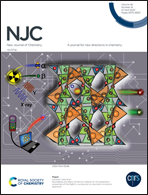The in situ construction of oxygen-vacancy-rich NiCo2S4@NiMoO4/Ni2P multilevel nanoarrays for high-performance aqueous Zn-ion batteries†
Abstract
The development of active and durable cathode materials is the key to achieving high-performance water-based zinc-ion batteries. In this work, NiCo2S4@NiMoO4/Ni2P nanoarrays were prepared using a hydrothermal and subsequent phosphine vapor-assisted reconstruction strategy. NiCo2S4@NiMoO4/Ni2P shows rich oxygen vacancies, which is a benefit for improving the catalytic reaction kinetics. Notably, in situ-derived Ni2P nano-particles can increase the electrical conductivity while also acting as active sites for fast redox reactions. The unique multilevel nanoarray formed using the phosphine vapor-assisted reconstruction strategy further accelerates the mass-transfer process. Benefiting from these intrinsic properties, the NiCo2S4@NiMoO4/Ni2P electrode shows a good electrochemical performance. The NiCo2S4@NiMoO4/Ni2P materials deliver an outstanding specific capacity (258 mA h g−1 at 2 A g−1) and excellent rate capability (65.6% retained at 6 A g−1). Moreover, the NiCo2S4@NiMoO4/Ni2P//Zn battery exhibited an outstanding specific capacity (231 mA h g−1 at 1 A g−1), prominent stability (122% after 5000 cycles) and a remarkable energy density of 384 W h kg−1 at 0.46 kW kg−1.



 Please wait while we load your content...
Please wait while we load your content...